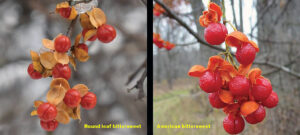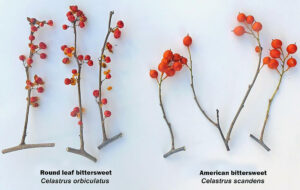By Erika Segerson-Mueller, DNR Invasive Plant Program Specialist, Oshkosh;
Erika.SegersonMueller@wisconsin.gov or 715-492-0391
Native plants benefit Wisconsin wildlife, pollinators and ecosystems. However, many resemble harmful invasive species, making identifying problem plants in the woods challenging.
It is important to learn a few key characteristics to unmask the imposters and correctly identify the invasive plants. With a little study and practice, you can quickly differentiate between these perplexing pairs.
In part one of this series, we looked at three commonly confused pairs, comparing one invasive plant and one lookalike native plant. Here are three more pairs to learn and know:
1. Invasive giant hogweed (Heracleum mantegazzianum) vs. native cow parsnip (Heracleum maximum)

Giant hogweed (left) and native cow parsnip (right) have similar umbel-shaped flowers. Hogweed is taller (up to 15 feet) and has wider stems (2-4 inches in diameter); cow parsnip grows no taller than 8 feet with stems 1-2 inches in diameter. / Image Credits: Left, USDA APHIS PPQ – Oxford, North Carolina, Bugwood.org; Right, Wisconsin DNR
Like wild parsnip, giant hogweed is another invasive plant of high public interest due to the potential for contact phytophotodermatitis (a skin rash following contact with ultraviolet light). While populations of giant hogweed are infrequent in Wisconsin, the plant is often confused with the abundant and pollinator-friendly native cow parsnip.
Giant hogweed lives up to its name, growing 8 to 15 feet high, while cow parsnip tops out at 8 feet or shorter. The flowers on both plants are similarly shaped in umbels, but giant hogweed clusters are much larger (1 to 3 feet across). Hogweed stems are also much larger, growing 2-4 inches in diameter.
Check out the DNR’s giant hogweed vs. cow parsnip publication to review the differences between the species.
2. Invasive multiflora rose (Rosa multiflora) vs. native prairie rose (Rosa arkansana)

Invasive multiflora rose (left) has many flowers blooming in clusters. Native prairie rose (right) has larger blooms that are often pink. / Image Credits: Left, Denise Ellsworth, The Ohio State University, Bugwood.org; Right, Katy Chayka, Minnesota Wildflowers, www.minnesotawildflowers.info
Multiflora rose is an invasive shrub that can be easily found in woodlands, especially in the southern portion of the state. As its name suggests, multiflora (many-flowered) shrubs have many roses growing in distinct clusters. While multiflora roses are white or slightly pink, the color of native blooms can vary, but they are often pink and larger in size.
Other characteristics that differentiate the invasive from the native species require a closer look at the leaf stalks and stems. The invasive multiflora rose has backward-curving barbs, whereas native roses have slender, straight thorns.
You can also identify an invasive rose by finding the stipules (hair-like protrusions at the base of each leaf stem where they meet the stalk). Stipules are distinctly fringed on the invasive multiflora rose and are a simple smooth pair on the native.

Invasive round leaf bittersweet (left) and the native species American bittersweet (right) have similar appearances. Berries grow all along the stems of the invasive, while larger berries grow only at the tips of stems on the native species. / Image Credits: Minnesota Department of Agriculture
3. Invasive round leaf bittersweet (Celastrus orbiculatus) vs. native American bittersweet (Celastrus scandens)
Invasive round leaf bittersweet, also known as Oriental bittersweet, is a popular decoration in the fall and winter months due to its showy berries. The red-orange fruits grow all along the branches of this invasive, strangling vine. When used in décor, new infestations may be spread from still-viable plant seeds or debris during transport or when improperly discarded.
Wisconsin’s Invasive Species Rule NR40 prohibits the sale or transfer (including as gifts) of 145 restricted plant species, including round leaf bittersweet. However, fans of the plant can still get the look of bittersweet without the nasty invasions by opting for American bittersweet instead.
To identify the native vs. the invasive bittersweet, look closely at the fruit. Round leaf bittersweet has red-orange berries all along the stem; American bittersweet has berries just at the end of each stem. The fruits of American bittersweet are also larger than those of the invasive bittersweet.
There are plenty more invasive plants to learn to identify, so once you’ve mastered these pairs, check out the DNR’s Regulated Species webpage for more identification information and common lookalikes.

Invasive round leaf bittersweet (left) and the native species American bittersweet (right) have similar appearances. Berries grow all along the stems of the invasive, while larger berries grow only at the tips of stems on the native species. / Image Credits: Minnesota Department of Agriculture.
